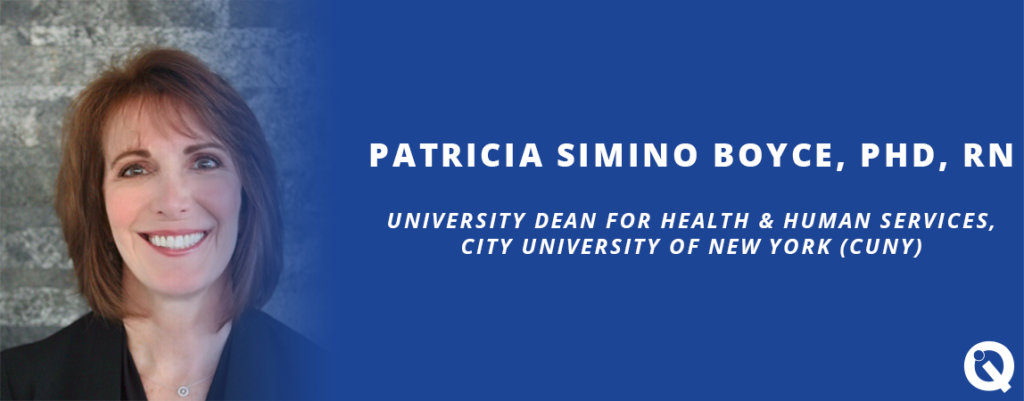Patricia Simino Boyce, PhD, RN, is the University Dean for Health and Human Services at the City University of New York (CUNY). She will deliver the keynote address at the Quality Institute’s Spring All Council Conference, Building a Health Care Workforce for the Future, on May 18.
In your role at CUNY, how do you prepare your students for the challenges they will face in health care careers?
We build bridge programs and career pathways to high-demand fields such as nursing, respiratory therapy, and roles such as medical lab technicians. We work on developing academic practice partnerships — where we have a shared agenda around specific strategic objectives to facilitate student training, residencies, and hiring pipelines. We also have a university-wide initiative engaging students across health professions in interprofessional education to prepare them for team-based care. And we work on expanding curricula, and experiential learning activities across our health and human service programs.
What do you see as the most pressing challenges your students are facing as they enter the workforce?
One is the transition to the workplace. The increase in staff vacancies has challenged onboarding and transition to practice for our students. The infrastructure to support them is not the same and the practice environment is changing so quickly. So that’s created some instability in the ability of health care systems to support onboarding and successful transitioning of students into professional practice. And there’s other seismic shifts from hospital to ambulatory and home-based care — along with new and expanded competencies for students’ entry to the workforce. And some of the clinical and field experiences gaps during COVID need to be addressed in terms of enhancing skills prior to graduation. So, there are different challenges, both on preparation and in the transition to the workplace itself.
You will be the keynote speaker at the Quality Institute’s Spring All Council Conference. What will you discuss regarding lessons in New York that could be valuable to New Jersey?
For 25 years, we’ve had a centralized source of health care workforce data in the state at the Center for Health Workforce Studies. So that has been tremendously helpful during the pandemic because we already have a state entity that provides and looks at data and helps inform education and practice needs and priorities. We also have some historic investments from the state, particularly this fiscal year, to address these issues. We have funding for health care workers, such as bonus pay, scholarship funds, nursing faculty incentives, and expanded legislation to survey health professions through state licensing procedures to inform and get more folks into the pipeline. There’s a lot of coordination happening in the entire state and downstate, and by downstate, I mean New York City. There’s a lot of coordination happening with hospital membership, small business services, educational partners, and labor unions to really think about addressing the critical pipeline needs. We’re working to know: what are the needs and challenges, and how we can work differently in terms of our partnerships to address the capacity issues of our health system?
How are you using data and transparency in health care workforce development?
Data provides critical information, such as on education trends and graduations. I was just working with data experts at the SUNY Albany this morning looking at changes in this past year. The data looks at both opportunities and gaps around what’s happening. It defines workforce shortage areas, trends, licensure information, and attrition rates. It also really helps us understand shortage areas by jurisdictions across the state and informs funding and policy needs to address specific concerns. Similarly, when we do invest in policy, legislation, and funding, data helps us understand the impact. We also look at demographics to gage which professions are under-represented. Where do we need to bolster representation in terms of enrollment across our programs in the state? And it also helps us understand enrollment and graduation trends. In some cases, the pipeline is strong, but the workforce isn’t. There’s lots of different variables and we put them all together.
Finally, we like to ask a question beyond a person’s professional life. Where might we find you on a day away from work?
This time of year, I’d say I’m spending time on long walks with my dogs because I love the springtime, and I particularly love to watch all the cherry blossom trees bloom in my neighborhood. I’m getting my decks and patios ready for summer. I love this time of year.

